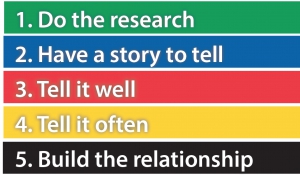Every community and organization needs an effective marketing and communications plan. How else will you know if you’re on the right track, reaching the right folks with the right messages? Here are five key steps to keep in mind when putting a plan together.
1. Do the research
Perform a situational analysis – meaning, conduct an audit or review of your current efforts. How’re you doing now: what works? What doesn’t? How are others doing it? Research such as surveys or brainstorming with staff and stakeholders can reveal gaps in your current marketing efforts, and uncover specific business needs – and opportunities. It’s best to define your key objectives at this stage, as well as identifying key audiences. Who do you plan to reach out to – and how do you want them to respond?
2. Have a story to tell
Start with identifying your key economic indicators: what are your community’s main strengths? What are the main benefits of your community’s location? Is it the resilient nature of your people? The stunning natural features? A location critical to regional development? What makes you remarkable? What is the ‘Why?’ about your community or organization?
3. Tell it well
Always lead with benefits, of course. People always want to know ‘What’s in it for me?’ But different audiences have different needs, and messages must be developed that will resonate with their intended targets. Having a strong brand is part of telling it well. It also means supporting the message with well-designed and creative materials, grabbing the attention of the recipient so they can see value in reading further. Do you need a tagline? Are headlines and text crafted to portray a compelling narrative? Is the brand presented consistently across various platforms?
4. Tell it often
Marketing studies show that responses increase when an integrated, coordinated, multi-channel approach is taken. You will likely be considering a combination of traditional and digital media. Beyond simply purchasing media space or posting social media entries, there needs to be a process for keeping the marketing program on the rails. Timing is everything.
5. Build the relationship
This is the punch line: creating and nurturing those contacts with which you expect to do business. Whether it is a resident or business, customer or prospect, an industry representative or influencer – each of these groups or individuals has their own reasons for feeling connected and affirmed. Usually, the greater the connection, the stronger the relationship – and the higher the satisfaction level for all.
Keeping these five steps in mind will help you develop an effective plan, and lead to the long-term relationships and investments you’re seeking.


